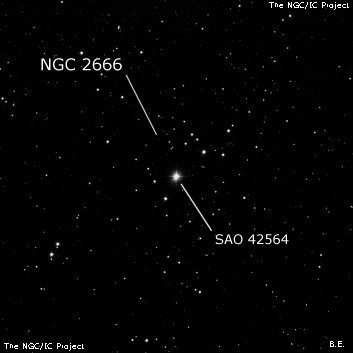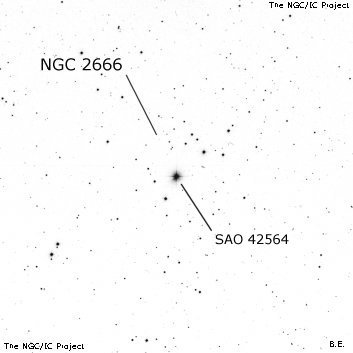NGC/IC Project Restoration Effort
(This is a very very beta version)
NGC2666


Basic Information
Location and Magnitude
Right Ascension: 8:49:47.3
Declination: +44:42:16
Constellation: LYN
Visual Magnitude:
Historic Information
Discoverer: Herschel J.
Year of discovery: 1828
Discovery aperture: 18.3
Observational
Summary description: Cl, lC
Sub-type: OCL
Corwin's Notes
=====
NGC 2666. JH's description reads only, "The chief * of a coarse cluster."
There is nothing resembling this at his position (08 50 03, +47 03.6; 2000).
Checking the sweep (139 on 19 March 1828) in the Herschel Archives, I found
that JH made at least a two-degree error in his reduction of the NPD; the
correct NPD should be approximately the same as those for NGC 2712 and
NGC 2776, both found later in the same sweep.
This makes it likely that the group of about a dozen stars around SAO 42564
(08 49 47.3, +44 42 16; J2000), which I had found earlier on the POSS1 print,
is indeed the correct object.
-----
Checking the sweep again in June 2016, I found that JH accidentally copied the
reduced NPD of the preceding object in the sweep (a double star) into the
column for the reduced NPD of this cluster. The difference in the NPD index
between the two objects is 2d 21' 18", leading to a corrected position for
JH's "chief *" of 08 38 14.8, 44 40 27 (NPD, 1830) or 08 49 49, +44 42.3
(J2000), very close to the position of the SAO star. The identity of JH's
object with the sparce group is no longer in any doubt.
Steve's Notes
=====
NGC 2666
18" (2/14/10): The HD 751354 group consists of nearly two dozen stars scattered around a mag 8 star. Three collinear stars (length 3') oriented SW to NE are 2' E of HD 75135. Another group of ~10 stars is scattered over a 5' region to the NW of the bright star. This group was visually uninspiring and appears to be an asterism.
18" (2/23/06): the only possible candidate near John Herschel's original position is a mag 11.7 star and a group of five mag 13.5-14.5 stars close south. Four of the stars are strung along a 5' gently curving arc. To the northeast is a much brighter 10' string of a half dozen stars that extends towards the northeast. Neither of these asterisms, though, are probably eye-catching enough to be mentioned as a "course cluster". Note: Based on more recent historical investigation, this identification is incorrect.



